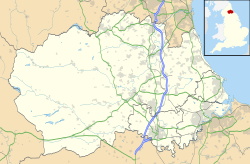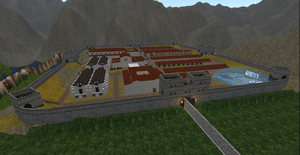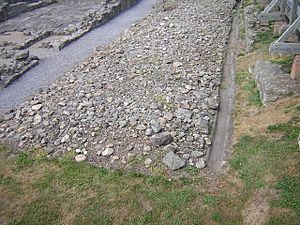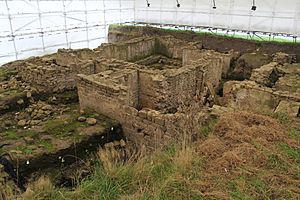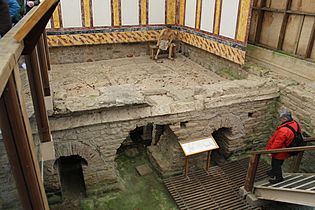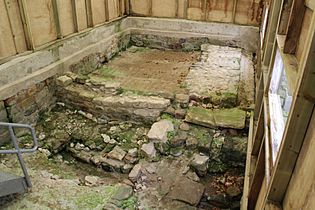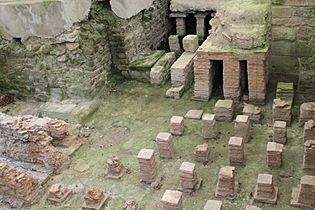Vinovia facts for kids
Quick facts for kids Vinovia |
|
|---|---|
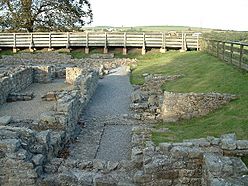
The ruins
|
|
| Alternative name(s) | Vinovium |
| Known also as | Binchester Roman Fort |
| Founded | c. AD 79 |
| Abandoned | c. 5th century |
| Place in the Roman world | |
| Province | Britannia |
| Stationed military units | |
| — Legions — | |
| VI Victrix | |
| — Alae — | |
| I Vettonum | |
| Location | |
| Coordinates | 54°40′34″N 1°40′37″W / 54.676°N 1.677°W |
| Town | Bishop Auckland |
| County | County Durham |
| Country | England |
| Reference | |
| UK-OSNG reference | NZ208313 |
| Site notes | |
| Condition | Ruined |
Vinovia or Vinovium was a Roman fort and settlement. It was located in County Durham, England, just north of Bishop Auckland. The fort was built on the banks of the River Wear. Today, its ruins are known as the Binchester Roman Fort.
Contents
What Was Binchester Roman Fort?
Binchester Roman Fort, also called Vinovia, was a very important place in Roman Britain. It was built around AD 79 to protect a key crossing point of the River Wear. This crossing was part of Dere Street, a major Roman road. Dere Street connected important cities like York to Hadrian's Wall and even Scotland.
How Was the Fort Built?
Binchester Fort was the largest Roman fort in County Durham. It sat high on a hill, about 15 meters above the River Wear. Before building began, the Romans cleared the land of trees and bushes. They then laid down a huge layer of earth to make the ground flat.
The first buildings inside the fort were made of timber. These were likely barracks where soldiers lived. Later, these timber buildings were replaced with stronger stone structures. These included a large house for the fort's commander and a fancy bathhouse. These stone buildings were changed and improved many times over the years.
Who Lived at the Fort?
We don't know exactly which Roman army units were always stationed at Binchester. However, records mention a few groups. These include cavalry (horseback soldiers) from the ala Vettonum. There were also Frisian soldiers and even part of the famous Legio VI Victrix (Sixth Legion). It's possible that soldiers from the Sixth Legion were the ones who built the fort in the first place.
What Was the Civilian Settlement?
Outside the fort walls, there was a large civilian settlement called a vicus. This was where families, traders, and others who supported the soldiers lived. Today, the remains of this settlement are buried under farmland.
Some parts of the fort and settlement have been lost over time. For example, the southern part of the fort is now under Binchester Hall. A landslide in the 1800s also destroyed some of the fort's defenses. You can still see parts of the stone bridge that Dere Street used to cross the River Wear when the water is low. In 2007, archaeologists found several burial places (mausolea) north of the settlement.
What Happened After the Romans Left?
The Roman army officially left Britain around 410 AD. However, people continued to live around Binchester. By the early 500s, an Anglo-Saxon cemetery was started there. People also began taking stones from the fort buildings to use for other constructions. Some of these stones were used to build the nearby Escomb Church in the 600s. A small village and a large house (manor house) remained at Binchester until the late Middle Ages. Today, a 17th-century building called Binchester Hall stands where the old manor house once was.
Discovering Binchester: Archaeological Digs
People have known about the ruins of Binchester Fort for a long time. Historians first wrote about it in the 1500s. They mentioned finding Roman coins and seeing old walls.
Early Finds and Challenges
In 1815, a farmer's cart accidentally fell into a hypocaust (an ancient Roman underfloor heating system). This led to the discovery of a Roman bath-house. Sadly, in the early 1800s, many valuable items like altars and urns were taken from the site. They were even used as props in local coal mines. In 1836, the fort and surrounding land became owned by the Anglican Church.
Victorian Era Excavations
The first proper archaeological digs happened between 1878 and 1880. These were led by John Proud and Reverend Robert Eli Hooppell. They explored the bath-house, parts of the fort's defenses, and some of the civilian settlement. Hooppell noted that most earlier finds had been lost or scattered. His team found a section of Dere Street that served as the fort's main road. They also uncovered several simple buildings in the civilian area.
In 1891, new water pipes were installed, damaging part of the fort. However, this work also uncovered a large Roman altar. It was dedicated to Jupiter and three Celtic mother goddesses.
20th Century Digs
In 1937, Kenneth Steer's excavations found evidence of buildings from after the Roman period. This suggested that the civilian settlement continued even after the fort was no longer actively used by the army. He also found an earlier fort built by Agricola beneath a later one from the 3rd century.
More work continued in the 1950s and 1960s. The bath suite was re-excavated and mostly cleared. In 1971, archaeologists found about six layers of timber barracks at the northwestern end of Binchester Hall.
From 1976 to 1988, a long-term excavation program focused on the bath suite and the commander's house. They found that the commander's house was built after the mid-4th century. It was a fancy house for one person. Later, a separate bath suite was added next to the house. This bathhouse had three rooms: a warm room, a hot room, and a hot room with two plunge baths. It was likely only for the commander at first.
Later, the house was divided into smaller units, and the baths were opened to all the soldiers. A coin from 350-360 AD suggests when these changes might have happened. Eventually, the baths and house fell into disrepair. Rooms were used for dirty work like blacksmithing and butchery. Walls and roofs collapsed, marking the end of the complex in the post-Roman period. The entire fort area was used as a cemetery from the mid-6th to the 11th centuries. A Saxon woman was even found buried in the rubble of the collapsed roof.
Recent Discoveries
In 2004, a geophysical survey mapped a large area of the civilian settlement. This survey uses special equipment to "see" what's buried underground without digging. It showed a very large settlement under the fields.
This led to the TV show Time Team visiting Binchester in 2007. They spent three days digging and found more remains of the older, larger fort. They also made an exciting discovery: three military mausolea (burial monuments). These were the first found in Britain in 150 years! Time Team also confirmed that the civilian settlement extended north of the fort.
New excavations began in 2009 and continued in 2010. Teams from Durham University and Stanford University worked together. They dug trenches both inside the fort and in the civilian settlement.
In 2018, a six-week dig involved 60 archaeologists and volunteers. They uncovered a Roman road, carved images, and several industrial buildings from the Roman era. These ongoing digs continue to reveal more about the fascinating history of Binchester Roman Fort.
Images for kids
See also
 In Spanish: Vinovia para niños
In Spanish: Vinovia para niños


